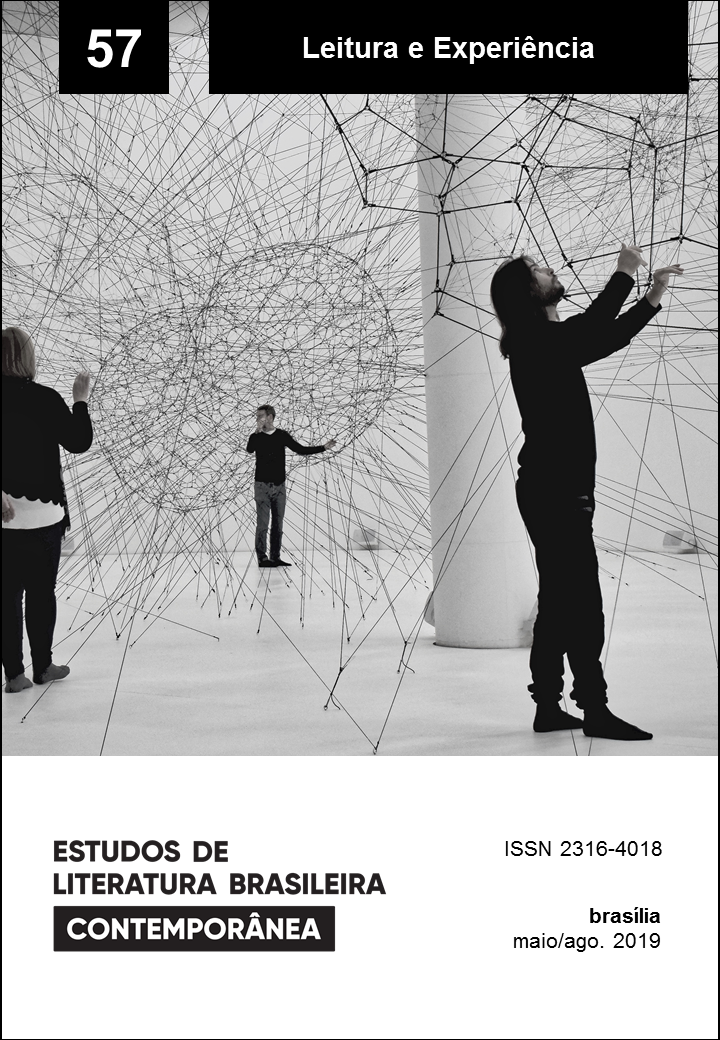Autofiction and experience in O pai da menina morta, by Tiago Ferro
DOI:
https://doi.org/10.1590/2316-40185710Keywords:
experience of the outside, literary experience, Tiago Ferro, autofictionAbstract
Based on the concepts of “experience of the outside” by Maurice Blanchot and “interior experience” by George Bataille, in this paper I analyze the displacement of the subject to the outside in the novel O pai da menina morta, by Tiago Ferro. Although Blanchot rejects the literary Self of the work and its personal speech, I propose, autofiction as a way of reading Ferro’s work. Autofiction materializes in the text not as a stylistic and critical device (as is often the case in contemporary literature), but as a displacement of the author’s empirical self to the other, engendering a double that no longer refers to a real precedent, neither consists in a copy, whose meaning is only effective with the reader and his personal experience that will fill in the blank spaces of the narrative. Therefore, I intend to demonstrate how both readings are not contradictory but complementary once the narrative core is displaced, after the loss experienced by the anonymous character and his need to adjust against absence. From his own experience, Ferro creates a lyrical and fragmented novel that, born from death, looks for what is still alive in this subject who neither wants to, nor can, be called the Self.
Downloads
References
AGAMBEN, Giogio (2005). Infância e história: destruição da experiência e origem da história. Tradução de Henrique Burigo. Belo Horizonte: Ed. UFMG.
BATAILLE, Georges (2016). A experiência interior: seguida de Método de Meditação e Postscriptum 1953: Suma ateológica. Tradução de Fernando Scheibe. Belo Horizonte: Autêntica. v. 1.
BENJAMIN, Walter (1996). Experiência e pobreza. In: BENJAMIN, Walter. Magia e técnica, arte e política: ensaios sobre literatura e história da cultura. Tradução de Sérgio Paulo Rouanet. São Paulo: Brasiliense. p. 114-119. (Obras escolhidas, v. 1).
BENJAMIN, Walter (1996). O narrador. Considerações sobre a obra de Nikolai Leskov. In: BENJAMIN, Walter. Magia e técnica, arte e política: ensaios sobre literatura e história da cultura. Tradução de Sérgio Paulo Rouanet. São Paulo: Brasiliense. p. 197-221. (Obras escolhidas, v. 1).
BLANCHOT, Maurice (2011). A parte do fogo. Tradução de Ana Maria Scherer. Rio de Janeiro: Rocco.
BLANCHOT, Maurice (2005). O livro por vir. Tradução de Leyla Perrone-Moisés. São Paulo: Martins Fontes.
DOUBROVSKY, Serge (1988). Autobiographiques: de Corneille à Sartre. Paris: Presses Universitaires de France.
DOUBROVSKY, Serge (2007). Les points sur ler “i”. In: JEANNELLE, Jean-Louis.; VIOLLET, Catherine. (Dir.). Genèse et autofiction. Louvain-la-Neuve: Academia. p. 54-65.
DOUBROVSKY, Serge (2011). C’est fini. Entretien réalisé par Isabelle Grell. In: FOREST, Philippe (Dir.). La Nouvelle Revue Française, Paris, Gallimard, n. 598, Je & Moi, oct.
DOUBROVSKY, Serge (2014). Serge Doubrovsky, inventeur de l'autofiction: “Un individu, ce n'est pas que beau à voir”. Entrevista concedida a Nathalie Crom. Télérama, Paris, 29 ago. 2014. Disponível em: https://bit.ly/2JJkvQ9. Acesso em: 20 jun. 2018.
FERRO, Tiago (2018). O pai da menina morta. São Paulo: Todavia.
FERRO, Tiago (2016). Postagem em página pessoal no Facebook, 6 abr. Disponível em: https://bit.ly/2HqCARv. Acesso em: 25 mar. 2018.
GASPARINI, Philippe (2004). Est-il je? Roman autobiographique et autofiction. Paris: Seuil.
HUBIER, Sébastien (2003). Littératures intimes: les expressions du moi, de l´autobiographie à l´autofiction. Paris: Armand Colin.
KNAUSGÃ…RD, Karl Ove (2015). Minha luta: a morte do pai. Tradução de Leonardo Pinto Silva. São Paulo: Companhia das Letras.
LEVY, Tatiana Salém (2011). A experiência do fora: Blanchot, Foucault e Deleuze. Rio de Janeiro: Civilização Brasileira.
LOPES, Denilson (2002). Experiência e literatura. In: LOPES, Denilson. O homem que amava rapazes e outros ensaios. Rio de Janeiro: Aeroplano.
MEIRELES, Maurício (2018). Luto inspira 1º romance de Tiago Ferro. Folha de S. Paulo, São Paulo, Caderno Ilustrada, 14 mar. Disponível em: https://bit.ly/2VIG2zv. Acesso em: 20 jun. 2018.
PINEZI, Gabriel V. R. (2015). A experiência literária de Jack Kerouac: a criação da liberdade, a liberdade da criação. Tese (Doutorado em Letras) ”“ Universidade Estadual de Londrina, Londrina. Disponível em: https://bit.ly/2HA9C0b. Acesso em: 20 jun. 2018.
RANCIÈRE, Jacques (2005). A partilha do sensível: estética e política. Tradução de Mônica Costa Netto. São Paulo: Editora 34.
WOOD, James (2017). A coisa mais próxima da vida. Tradução de Denise Bottmann. São Paulo: SESI-SP.
ŽIŽEK, Slavoj (2011). Bem-vindo ao deserto do real. Tradução de Paulo Cézar Castanheira. São Paulo: Boitempo.
Published
How to Cite
Issue
Section
License
Authors who publish in this journal agree to the following terms:
a) The authors maintain the copyright and grant the journal the right of first publication, the work being simultaneously licensed under the Creative Commons Attribution License-Non Commercial 4.0 which allows the sharing of the work with acknowledgment of the authorship of the work and publication this journal.
b) Authors are authorized to enter into additional contracts separately, for non-exclusive distribution of the version of the work published in this journal (eg publish in institutional repository or as a book chapter), with authorship recognition and publication in this journal.
c) Authors are allowed and encouraged to publish and distribute their work online (eg in institutional repositories or on their personal page) after the editorial process, as this can generate productive changes, as well as increase the impact and citation of published work (See The Effect of Free Access).
d) The authors of the approved works authorize the magazine to, after publication, transfer its content for reproduction in content crawlers, virtual libraries and the like.
e) The authors assume that the texts submitted to the publication are of their original creation, being fully responsible for their content in the event of possible opposition by third parties.


